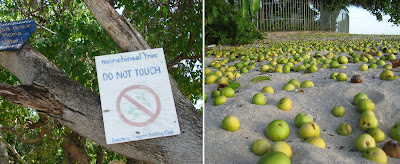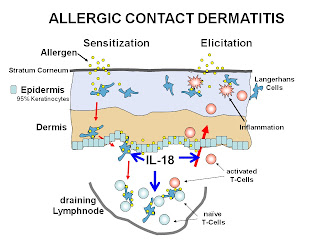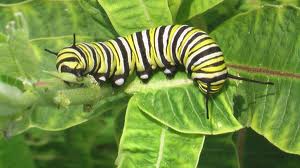Biology concepts – toxin, poison, urushiol, oleander, hapten, allergic contact dermatitis
Most birds just stay away from monarchs most of the time, but even this has weirdness associated with it. Monarchs lose toxicity as they age, and males usually have less toxin than females, yet somehow the birds can sense it. Research has shown that monarchs with higher levels of toxin are less likely to be attacked by a predator. How do the birds know?
Bas, A., Demirci, S., Yazihan, N., Uney, K., & Ermis Kaya, E. (2012). Nerium oleander Distillate Improves Fat and Glucose Metabolism in High-Fat Diet-Fed Streptozotocin-Induced Diabetic Rats International Journal of Endocrinology, 2012, 1-10 DOI: 10.1155/2012/947187
Suk, K., Baik, S., Kim, H., Park, S., Paeng, K., Uh, Y., Jang, I., Cho, M., Choi, E., Kim, M., & Ham, Y. (2011). Antibacterial Effects of the Urushiol Component in the Sap of the Lacquer Tree (Rhus verniciflua Stokes) on Helicobacter pylori Helicobacter, 16 (6), 434-443 DOI: 10.1111/j.1523-5378.2011.00864.x
Garg, A., Buchholz, T., & Aggarwal, B. (2005). Chemosensitization and Radiosensitization of Tumors by Plant Polyphenols Antioxidants & Redox Signaling, 7 (11-12), 1630-1647 DOI: 10.1089/ars.2005.7.1630
A cloudburst threatens to ruin your summer hike. You dart under a tree for protection from the rain and break out a granola bar. You decide to wait it out, but after a few minutes, your skin starts to itch and your eyes sting. After a few more minutes, you notice a rash on your arms and your throat feels like it's closing. Is it bad granola? Is it acid rain? Are you going to die?
No, no, and maybe. You just picked the wrong tree to use as an umbrella. This is the manchineel tree (Hippomane manciella), native to several countries in the around the Americas and the Caribbean.
The latex that oozes from this tree contains the toxins hippomanin A and B. Both toxins are present in the latex, leaves, bark, wood, roots, fruit, flowers, and nectar of the manchineel. Eat it or rub against it, and you get sick. Cut it up and the sawdust makes you sick; get it in your eyes (even the smoke from burning it) and you can go blind!
Most deaths have occurred from eating the apple of the manchineel; hence the common name for the tree – the Death Apple. Your mucosal surfaces blister, your larynx swells shut, your GI system rebels loudly and explosively. Massive hemorrhage can follow the closing of your throat, so you drown in your own blood.
In the 1500’s, South American Indians threw death apples down their own wells to poison the invading Spanish conquistadors. It worked because this toxic plant is an exception; it is sweet. Most often, plant toxins taste bitter and that's how we know to avoid them. The death apple’s taste prevents us from making a judgment that could save our life. Definitely, this is a plant to be respected and feared.
Now that I have your attention, let’s talk about a seemingly more common plant toxin. Urushiol is the name for the offending group of molecules in poison ivy, poison oak, poison sumac, even more exotic plants like mango, lacquer trees and cashew nuts.
The urushiol (Japanese for lacquer) is exuded from the leaves and stems of the offending plants, and is found in the cashew nut shell. Skin contact leads to blisters and a rash; these are seen earlier in patches that get a larger dose. Urushiol is only partly water soluble, so it can stay on the skin or other surfaces and be spread for quite a while. It can stay on clothes until they are washed; even if that may be years, as in the case with my teenagers.
Urushiol toxicity comes from the immune reaction it generates in about 60-80% of the population. However, urushiol doesn’t spark an immune response on its own. It turns your body against itself. Immune responses are aimed at antigens (not born of, so not self), but urushiol breakdown products are haptens (to fasten to); think of them as half antigens. Haptens must combine with something else to become full antigens. In the case of urushiol, they combine with proteins from our own cell membranes.
When portion of the urushiol combines with the integral protein, now the protein is seen as foreign and your immune system might start to attack, in a process called type IVdelayed hypersensitivity. This produces inflammation and tissue damage in a reaction termed allergiccontact dermatitis.
As with other allergy reactions, contact dermatitis requires a sensitizing dose, in which your body is exposed to the allergen and ramps up a small reaction. Subsequent episodes are worse because part of the allergic reaction in the immune system sticks around (immune memory).
Not everyone’s immune system recognizes or overreacts to the hapten + membrane protein, so not everyone gets a rash from poison ivy – lucky devils! Other permutations are possible as well. You can be resistant and then develop an allergy late in life, or you can have contact dermatitis when young and later on become resistant. We know a lot about allergic hypersensitivity, but there's also a lot we don’t know. Much research is underway on plant toxins and allergens.
And herein lies the rub - pun intended - with many toxic plants. They cause pain, damage and irritation, yet Paracelsus said, “only the dose makes the poison.” Does that mean that a lower dose has no effect? Well, most of our medicines – antibiotics, anti-cancer, anti-depressive - come from fungi and plants. It isn’t just that less may not be harmful; less might actually be helpful!
Take urushiol for instance. A 2011 study shows that urushiol can kill H. pylori, the bacterium that causes many stomach ulcers. Within 10 minutes, urushiol can strip the membrane off of the bacterium and cause it to lyse. Traditional treatments were found to eradicate the disease in 75% of cases, but adding urushiol brought a 100% cure rate. It even worked in a mouse model, but no one asked the mice if their stomachs itched. Even hippomanin A is an inhibitor of herpes simplex virus 2 replication. It seems that every toxic plant we talk about here has some medicinal use – nothing and nobody are completely evil.
There are several plants that could wrestle for the title of most toxic, but anyone’s top five contenders would have to include oleander (Nerium oleander). You can die just from eating honey collected from bees that landed on the plant and partook of the pollen or nectar.
The principal toxin is oleandrin, a cardiac glycoside. This type of toxin messes with the electrical impulse generation in heart muscle cells. As a result of the toxin, cardiac activity is dysfunctional, often to the point of arrythmia and heart attack. In other cells, it interferes with calcium levels and can induce cell death. Despite these evil tendencies, oleandrin is proving to be a very useful medicine.
A 2012 study has shown that oleander distillate is therapeutic in diabetes. Rats with induced diabetes were treated with oleander extracts for 12 weeks. Those treated rats had better blood sugar levels, reduced insulin resistance and cholesterol, and improved insulin levels. Not only was the diabetes positively affected, but fat levels were also positively affected – all through treatment with a lethal poison.
But wait - there’s more! Oleandrin has been show to be effective in inhibiting cancer. In at least five different kinds of cancer, oleandrin can stop cancer cells from increasing in number (proliferating), and can even induce the cancer cells to kill themselves (apoptosis). That’s a good start, but it gets better.
A 2005 review discusses the idea of resistance to treatment that develops in many cancers over time. Wouldn’t it be great if we had something that could make the cancer cells sensitive to the drug treatments again? Well, this review discusses studies that show oleandrin can do just that. Oleandrin acts not only as a chemosensitizer, but makes cancer cells more sensitive to radiation therapy. Therefore, oleander is synergistic with other cancer therapies and makes them work better.
Can you stand any more wondrous uses for this poison? A more recent study indicates that oleandrin reduces infectivity of HIV. AZT, a traditional HIV drug, reduces replication but not infectivity, while oleandrin reduces infectivity but not replication, so they could work together. Oleander can save you from infectious diseases, cancers, and metabolic diseases – but eat the berries on your next hike and you’ll die a horrible death.
So humans are animals that can’t just willy-nilly start munching on toxic plants. But other animals can. We have talked about animals that use the toxins they eat (2˚ toxin sequestering), usually from either insects or plants. But is there an exception – does any animal sequester a toxin that its prey sequestered from a plant? I looked for one.There is a cuckoo that eats the cinnabar moth caterpillar that eats toxic ragwort. The plant has alkaloids. In the stomachs of most animals, they are quickly converted to toxins. But a 2012 study shows that the cinnabar moth caterpillar’s enzymes can convert the metabolic products back to their non-toxic alkaloid forms. Then they are ready to poison the unwitting animal that eats the caterpillar and hasn’t had the forethought to evolve a detoxification process!
However, the common cuckoo (Cuculus canorus) avoids the toxins in the cinnabar caterpillar by biting off the head of the larvae and discarding it, then shaking the carcass to expel the liquid toxin. This is like how some birds can eat monarch butterflies. Monarchs are toxic, having sequestered milkweed toxins they ate as caterpillars. Shining cuckoos in New Zealand and some North American birds know to get rid of the most toxic portions and just eat the rest. Therefore, these birds are not 3˚ toxin sequesterers. I couldn’t find an example – can you?
Most birds just stay away from monarchs most of the time, but even this has weirdness associated with it. Monarchs lose toxicity as they age, and males usually have less toxin than females, yet somehow the birds can sense it. Research has shown that monarchs with higher levels of toxin are less likely to be attacked by a predator. How do the birds know?
We have just touched the surface of toxic plants; there are more than we can mention. In Australia alone there are said to be over 1000 toxic plants! Let’s next look to our exceptions; plants that aren’t just toxic, they’re venomous.
For more information, see:
Plant toxins –





